Increasing Urbanization
The Global Wet Waste Management Market Industry is experiencing growth driven by rapid urbanization. As populations migrate to urban areas, the volume of wet waste generated increases significantly. For instance, cities are projected to account for 68 percent of the global population by 2050, leading to a surge in waste production. This urban expansion necessitates efficient waste management systems to handle the rising quantities of organic waste. Consequently, municipalities are investing in advanced waste management technologies and infrastructure to ensure sustainable practices. The Global Wet Waste Management Market is expected to reach 116.3 USD Billion in 2024, reflecting the urgent need for effective solutions.
Market Growth Projections
The Global Wet Waste Management Market Industry is projected to experience steady growth, with estimates indicating a market size of 116.3 USD Billion in 2024 and a potential increase to 164.0 USD Billion by 2035. This growth trajectory reflects a compound annual growth rate (CAGR) of 3.17% from 2025 to 2035. Such projections underscore the increasing demand for effective waste management solutions in response to urbanization, regulatory pressures, and environmental awareness. The market's expansion is likely to be supported by ongoing investments in technology and infrastructure, as stakeholders seek to enhance their waste management capabilities and meet evolving consumer expectations.
Technological Advancements
The Global Wet Waste Management Market Industry is witnessing a surge in technological advancements that enhance waste processing efficiency. Innovations such as anaerobic digestion, composting technologies, and smart waste management systems are transforming how wet waste is handled. These technologies not only improve waste processing but also contribute to energy recovery and resource conservation. For instance, anaerobic digestion can convert organic waste into biogas, providing a renewable energy source. As these technologies become more accessible and cost-effective, their adoption is expected to rise, further propelling market growth. The integration of technology in waste management practices is likely to play a pivotal role in shaping the industry's future.
Growth of the Circular Economy
The Global Wet Waste Management Market Industry is increasingly aligned with the principles of the circular economy, which emphasizes resource recovery and waste minimization. As businesses and governments recognize the value of reusing materials, there is a growing focus on developing systems that facilitate the recycling and composting of wet waste. This shift not only reduces landfill dependency but also promotes sustainable practices that contribute to environmental conservation. The circular economy model encourages innovation in waste management technologies, fostering collaboration among stakeholders. As this paradigm gains traction, it is expected to significantly influence the market dynamics, driving growth and investment in wet waste management solutions.
Rising Environmental Awareness
The Global Wet Waste Management Market Industry is benefiting from heightened environmental awareness among consumers and businesses. As the public becomes more conscious of the environmental impacts of waste, there is a growing demand for sustainable waste management practices. Initiatives promoting composting and organic waste recycling are gaining traction, encouraging communities to adopt eco-friendly solutions. This shift in consumer behavior is prompting businesses to invest in sustainable waste management technologies. The increasing emphasis on corporate social responsibility further drives this trend, as companies seek to enhance their environmental credentials. This evolving landscape is likely to support the market's growth trajectory in the coming years.
Government Regulations and Policies
The Global Wet Waste Management Market Industry is influenced by stringent government regulations aimed at promoting sustainable waste management practices. Many countries are implementing policies that mandate waste segregation, recycling, and composting. For example, the European Union has set ambitious targets for reducing landfill waste and increasing recycling rates. These regulations compel municipalities and businesses to adopt innovative waste management solutions, thereby driving market growth. As governments enforce compliance, the demand for advanced technologies and services in wet waste management is likely to rise. This regulatory environment is expected to contribute to the market's expansion, with projections indicating a growth to 164.0 USD Billion by 2035.


























Leave a Comment